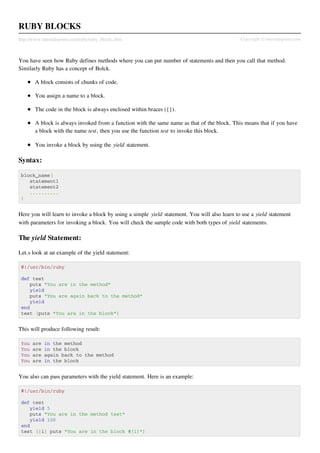
12 ruby blocks
- 1. RUBY BLOCKS http://www.tutorialspoint.com/ruby/ruby_blocks.htm Copyright © tutorialspoint.com You have seen how Ruby defines methods where you can put number of statements and then you call that method. Similarly Ruby has a concept of Bolck. A block consists of chunks of code. You assign a name to a block. The code in the block is always enclosed within braces ({}). A block is always invoked from a function with the same name as that of the block. This means that if you have a block with the name test, then you use the function test to invoke this block. You invoke a block by using the yield statement. Syntax: block_name{ statement1 statement2 .......... } Here you will learn to invoke a block by using a simple yield statement. You will also learn to use a yield statement with parameters for invoking a block. You will check the sample code with both types of yield statements. The yield Statement: Let.s look at an example of the yield statement: #!/usr/bin/ruby def test puts "You are in the method" yield puts "You are again back to the method" yield end test {puts "You are in the block"} This will produce following result: You are in the method You are in the block You are again back to the method You are in the block You also can pass parameters with the yield statement. Here is an example: #!/usr/bin/ruby def test yield 5 puts "You are in the method test" yield 100 end test {|i| puts "You are in the block #{i}"}
- 2. This will produce following result: You are in the block 5 You are in the method test You are in the block 100 Here the yield statement is written followed by parameters. You can even pass more than one parameter. In the block, you place a variable between two vertical lines (||) to accept the parameters. Therefore, in the preceding code, the yield 5 statement passes the value 5 as a parameter to the test block. Now look at the following statement: test {|i| puts "You are in the block #{i}"} Here the value 5 is received in the variable i. Now observe the following puts statement: puts "You are in the block #{i}" The output of this puts statement is: You are in the block 5 If you want to pass more than one parameters, then the yield statement becomes: yield a, b and the block is: test {|a, b| statement} The parameters will be separated by commas. Blocks and Methods: You have seen how how a block and a method can be associated with each other.You normally invoke a block by using the yield statement from a method that has the same name as that of the block. Therefore, you write: def test yield end test{ puts "Hello world"} This example is the simplest way to implement a block.You call the test block by using the yield statement. But if the last argument of a method is preceded by &, then you can pass a block to this method and this block will be assigned to the last parameter. In case both * and & are present in the argument list, & should come later. def test(&block) block.call end test { puts "Hello World!"} This will produce following result: Hello World! BEGIN and END Blocks
- 3. Every Ruby source file can declare blocks of code to be run as the file is being loaded (the BEGIN blocks) and after the program has finished executing (the END blocks). BEGIN { begin block code } END { end block code } A program may include multiple BEGIN and END blocks. BEGIN blocks are executed in the order they are encountered. END blocks are executed in reverse order.
